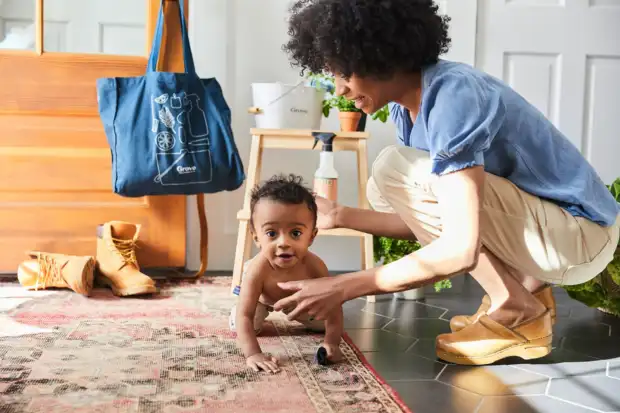
Baby safety guide for new parents.
Last Updated: March 11, 2021
We’ve put together our best tips and resources to help navigate baby safety protocols as a new parent. Read on to learn how to keep baby safe in all areas.
Welcoming a new baby into a household is a special time filled with many emotions. Keeping the baby safe begins immediately when a new baby arrives, even before the child begins moving around independently. New parents often have lots of questions about how to care for a new baby and how to prevent accidents. Follow recommended safety guidelines to keep your baby healthy and happy.
General baby safety
Most of the injuries that happen to babies are preventable. New parents often aren't aware of potential dangers until it's too late. Sometimes, babies grow and gain abilities faster than parents are aware, and then, they can get into trouble. Falls are a common occurrence. Even when a baby is a newborn, never leave the baby unattended on an elevated surface for even a second. If you can't keep your hands on your baby, place the infant in a safe place, such as the crib or a bassinet. Once a baby becomes mobile, close doors to prevent access to rooms. Place gates on stairs, and install window guards on all second-story and higher windows.
Safety in the bathroom
Infant bath water should be lukewarm. Babies don't need baths every day, but some parents like to give a soothing bath before bedtime. Try to bathe your baby two or three times each week. Never leave a baby unattended in the bath for a second, even if there's only a little water in the tub: Babies can drown in just an inch of water. Always keep the toilet seat down and the bathroom door closed to prevent your baby from having access to potential bathroom dangers.
Common household dangers
Monitor your baby carefully during waking hours. Choking is a common danger for children, whether a baby chokes on food or accidentally swallows a small item. Regularly inspect toys for loose parts, and always scan the floor for small items before your baby plays. Keep tiny objects out of reach of babies. Once babies become mobile, childproofing is crucial. Make wires and cords inaccessible, remove fragile objects from lower shelves and tables, place covers on sharp table corners, and use doorknob covers on doorknobs. Place pets' food and water bowls in a place where the baby can't access them. Cover power outlets with outlet protectors.
Food safety
Babies have weaker immune systems than adults do, so it's important to use safe food handling protocols when preparing a baby's food. Never feed a baby unpasteurized foods or beverages, partially cooked eggs, undercooked meats, raw sprouts, or honey. When feeding a baby food from a jar, portion out the food your baby will eat so you don't contaminate the food in the jar with the baby's saliva. Store leftover food in the refrigerator, only keeping strained meats for one day, vegetable and meat combinations for two days, and strained fruits and vegetables for three days. Young children are also at high risk of choking when they eat. Don't feed babies and young children small, hard foods such as nuts, chips, pretzels, seeds, popcorn, whole grapes and olives, and chunks of raw vegetables. Cut up meats such as hot dogs into small, lengthwise pieces. Sticky foods such as peanut butter, caramels, marshmallows, and dried fruits can also be dangerous, so avoid them. Always supervise meal time carefully.
Car safety
Car accidents are a major threat to a child's safety. Injuries and deaths to children as a result of car accidents are often preventable with the correct use of car seats. Babies must ride in car seats from the first ride home from the hospital and every ride thereafter. Never place infants in the front seat of a car. Always follow manufacturer instructions for car seat installation and use, and keep your child rear-facing for as long as the seat allows. If you aren't sure you've installed your car seat correctly, many local police stations will check it for you to determine if you're using it correctly.
More safety resources
- Baby Safety
- Newborn Baby Safety
- A Guide for First-Time Parents
- Child Safety: Keeping Your Home Safe for Your Baby
- About Sudden Infant Death Syndrome
- Crib Safety Tips
- Newborn Care and Safety
- Guidelines for Keeping Your Child Safe at Home
- Safety Tips for Babies
- Safety Tips for Bathing Your Baby
- Child Safety Tips
- Infant and Toddler Health: Stroller Safety
- Safe Sleep and Other Safety Tips
- Food Safety Tips for Young Children
- Safe Sleep for Your Baby
- Ten Ways to Keep Your Family Safe
- Child Safety in the Car
- Top Ten Child Car Seat Safety Tips
- Toy Safety
- Guide to Babywearing: Benefits, Safety Tips, and How To
Looking for more home advice, cleaning how-tos, and sustainable swaps you can make at home? Grove has you covered with our buying and cleaning guides. And let us know how if you have any cleaning questions (or share your own tips using #grovehome) by following Grove Collaborative on Instagram, Facebook, Twitter, and Pinterest.
If you're ready to make the transition to natural cleaning products, shop Grove Collaborative's cleaning essentials for the cleaning tools to tackle the job.
